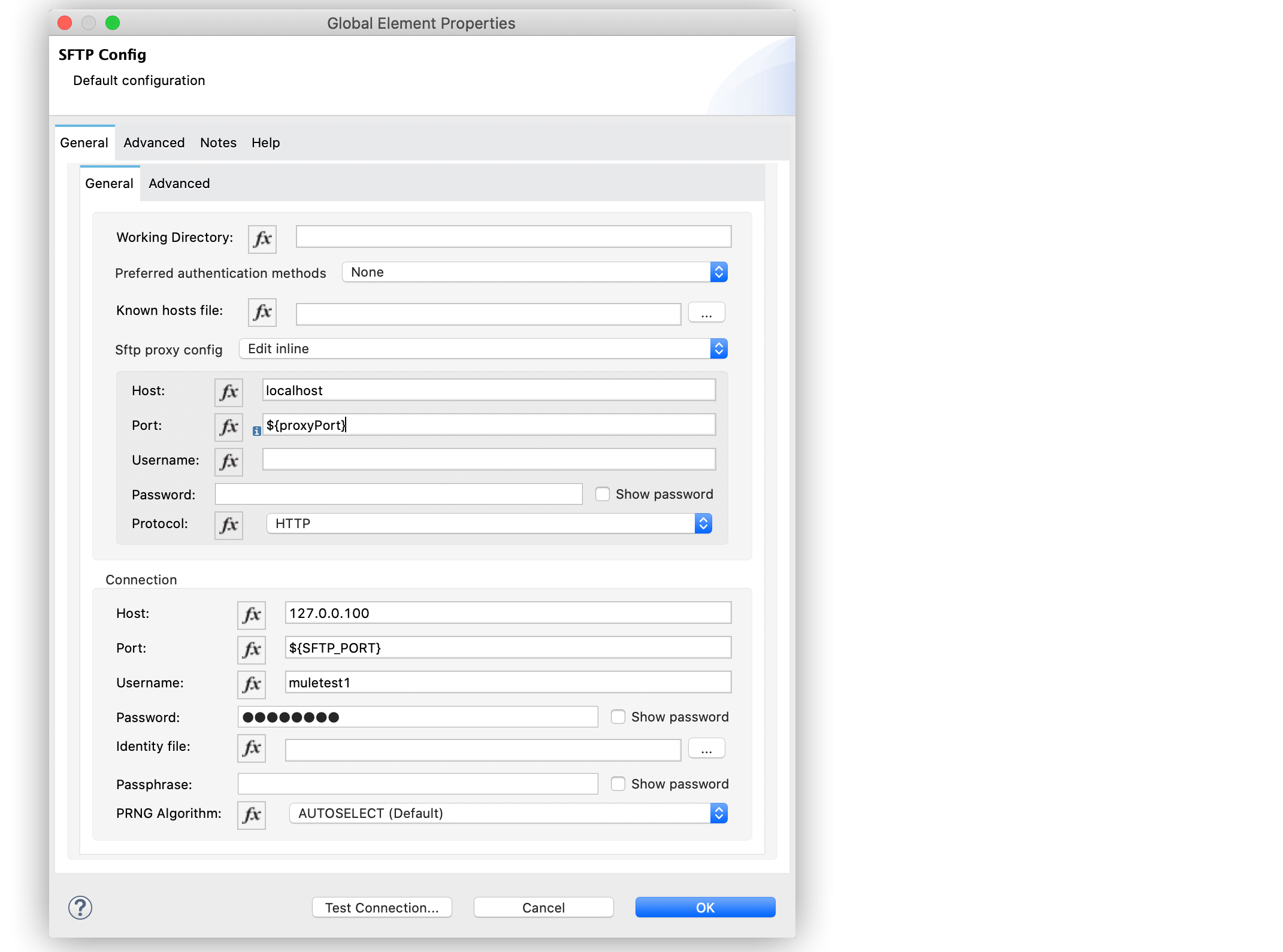
Connect to an SFTP Server Example
The following examples show how to configure Anypoint Connector for SFTP (SFTP Connector) global configuration element to:
Connect to an SFTP Server
To configure the global element to connect to an SFTP Server, follow these steps:
-
Select the name of the connector in the Studio canvas.
-
Select the operation in the Studio canvas.
-
In the configuration screen for the operation, click the plus sign (+) next to the Connector configuration field to access the global element configuration fields.
-
On the General tab, specify the connection information for the connector.
-
If you want EdDSA support, provide the EdDSA dependency by clicking Configure under the Required Libraries field.
-
Set the Working Directory field to
${workingDir}.
This is root of every relative path used with this connector. If it’s not provided, the value defaults to the remote server. -
Set the Host field to specify the SFTP server host, for example
localhostor192.168.0.1. -
Set the Port field to
${sftpPort}. -
Set the Username field to
anonymousand the Password field topassword. -
On the Advanced tab, optionally specify timeout configuration and reconnection strategy.
-
Click Test Connection to confirm that Mule can connect with the specified server.
-
Click OK.

In the Configuration XML editor, the configuration sftp:config looks like this:
<sftp:config name="sftp">
<sftp:connection username="anonymous" password="password"
host="localhost" port="${sftpPort}"
workingDir="${workingDir}"/>
</sftp:config>Connect to an SFTP Server Through a Proxy
To configure the global element to connect to an SFTP server through a proxy, follow these steps:
-
Select the name of the connector in the Studio canvas.
-
Select the operation in the Studio canvas.
-
In the configuration screen for the operation, click the plus sign (+) next to the Connector configuration field to access the global element configuration fields.
-
On the General tab, specify the connection information for the connector.
-
Set the Working Directory field to
${workingDir}.
This is root of every relative path used with this connector. If it’s not provided, the value defaults to the remote server. -
Set the Host field to
127.0.0.100. -
Set the Port field to
${SFTP_PORT}. -
Set the Username field to
muletest1and the Password field topassword. -
For the Sftp proxy config field, select Edit inline, and set the following fields:
-
Host:
localhost -
Port:
${proxyPort} -
Protocol:
HTTP
The protocol can be eitherHTTPorSOCKS5.
-
-
On the Advanced tab, optionally specify a timeout configuration and reconnection strategy.
-
Click Test Connection to confirm that Mule can connect with the specified server.
-
Click OK.

In the Configuration XML editor, the configuration sftp:config looks like this:
<sftp:config name="sftp">
<sftp:connection username="muletest1" password="password"
host="127.0.0.100" port="${SFTP_PORT}" workingDir="${workingDir}">
<sftp:sftp-proxy-config host="localhost" port="${proxyPort}" protocol="HTTP"/>
</ftp:sftp-connection>
</ftp:config>Configure a Public Key to Connect to an SFTP Server
The following example shows how to configure a public key as the preferred authentication method in your SFTP configuration. The example uses a PEM (Privacy Enhanced Mail) format certificate.
| Avoid storing private keys in your source code repository. For production, use secure configuration properties or a secrets manager. |
-
In Studio, navigate to the Global Elements tab.
-
Click Create.
-
Search for
sftp. -
Select SFTP Config.
-
Click OK.
-
In the Global Element Properties window, set Preferred authentication methods to Edit inline.
-
Click the plus sign to add a new value.
-
In the Preferred authentication method window, set Value to
PUBLIC_KEY. -
Click the plus sign to add a new value.
-
Set Value to
PASSWORD. -
Set Host to
sftp.host.com. -
Set Port to
22. -
Set Username to
sftp username. -
Set Password to
sftp password. -
Set Identity file to reference your PEM file using the
${app.home}property, for example${app.home}/keys/private.pem. Place the PEM file in your project’ssrc/main/resources/keysfolder. -
Set Passphrase to the password of the identity file.
-
Click OK.

In the Configuration XML editor, the configuration looks like this:
<sftp:config name="SFTP_Config" doc:name="SFTP Config" >
<sftp:connection host="sftp.host.com" username="sftp username" password="sftp password" identityFile="${app.home}/keys/private.pem" passphrase="passwordfile" >
<sftp:preferred-authentication-methods >
<sftp:preferred-authentication-method value="PUBLIC_KEY" />
<sftp:preferred-authentication-method value="PASSWORD" />
</sftp:preferred-authentication-methods>
</sftp:connection>
</sftp:config>


